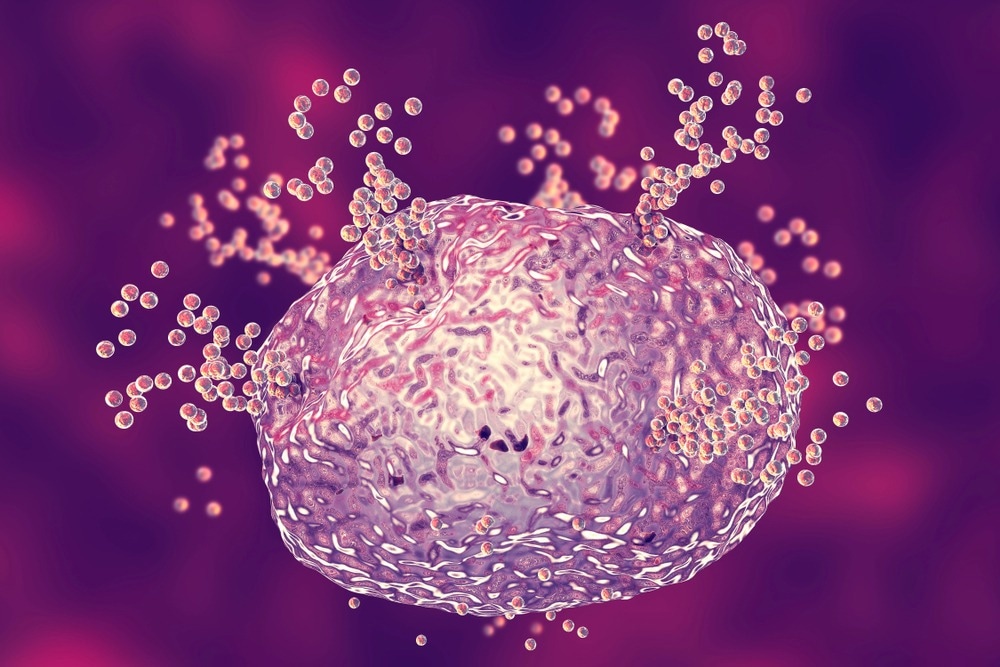Reviewed by Danielle Ellis, B.Sc.Jul 13 2023
Mast cells, part of the immune system, are still a puzzle. Mast cells function as a sensor that signifies the animals to avert antigens, including harmful allergens, and thus safeguard themselves from health-threatening inflammatory reactions, according to researchers at the German Cancer Research Center (DKFZ). The research was published in the journal Nature.

Image Credit: Kateryna Kon/Shutterstock.com
Mast cells are mainly found in tissues that separate the outside and inside worlds of the body, like the gastrointestinal tract and lungs’ epithelia. Mast cells are frequently found near nerve endings within tissues.
Mast cells are well known to allergy sufferers, but since they secrete messenger substances like histamine, which cause irritating to potentially life-threatening allergic symptoms. Mast cells are stimulated by IgE class antibodies during repeated antigen contact, resulting in these symptoms.
Why mast cells and IgE exist at all has not yet been conclusively explained.
Hans-Reimer Rodewald, German Cancer Research Center
In a combination of behavioral experiments and immunological studies, the DKFZ immunologist and his team were able to demonstrate for the first time in mice that mast cells act as a sensor that helps to avoid contact with allergens.
No Antigen Avoidance Without Mast Cells and IgE
The DKFZ investigators immunized mice with ovalbumin, a protein found in chicken egg white. They then gave the animals the option of drinking either normal or egg white-containing water. Immunized animals ignored the egg white-enriched water, whereas non-immunized counterparts clearly preferred it. One day after immunization, a large proportion of the immunized animals avoided the egg white-containing water, with some mice even refusing the first sip.
When the researchers conducted this behavioral test on mice that are genetically deficient in mast cells, both immunized and non-immunized animals preferred the egg white-containing water. Mice that were genetically unable to produce IgE exhibited no avoidance behavior. As a result, both mast cells and IgE are responsible for antigen avoidance.
When the immunized mice had no choice but to drink the egg white solution, they developed stomach and small intestine inflammation.
The avoidance behavior mediated by mast cells apparently protects the animals from harmful immune reactions.
Thomas Plum, Study First Author, German Cancer Research Center
How do Mast Cells “Talk” to the Brain?
A significant open question for the researchers was: How can mast cells, as immune system components, influence behavior? In what ways do immune cells “talk” with the brain? The researchers looked at a number of biologically active substances released by mast cells. Leukotrienes are pro-inflammatory messengers that are known to activate sensory nerves.
When the investigators inhibited leukotriene synthesis, the immunized mice no longer avoided egg white in the same way. As a result, leukotrienes appear to play a role in avoidance behavior. More immunological and neurobiological research is needed in the future to identify the nerve connections that transmit the mast cell signal to the brain.
In the intestine, lungs or skin, immune reactions against non-infectious antigens can occur as a result of so-called barrier disorders, permeability of the tissues from the outside to the inside. In the case of allergy, we call such antigens allergens. Whether these substances are dangerous or not, it is important for the organism to avoid their further intake in order to prevent inflammatory diseases. This is an evolutionary advantage and finally a conclusive explanation of the physiological role of mast cells and IgE.
Hans-Reimer Rodewald, German Cancer Research Center
Further research is needed to determine whether mast cells also help humans avoid harmful antigens.
Source:
Journal reference:
Plum, T., et al. (2023). Mast cells link immune sensing to antigen-avoidance behaviour. Nature. doi.org/10.1038/s41586-023-06188-0.